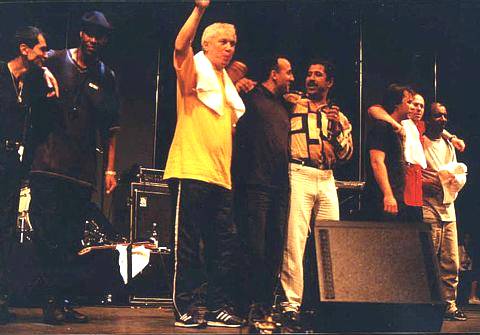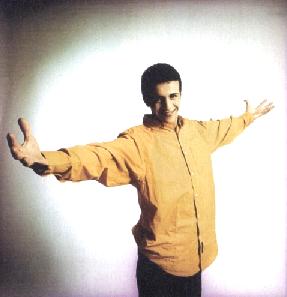| The groups of people who represent their selfhood
through their musical choices may be defined more
precisely by the concept of 'sound group' as developed by
Tullia Magrini. "Sound groups are formed by people
who choose a certain music mainly because they may
identify themselves with the values they connect to that
music" (Magrini 2000: 329). She also underlines that
"different sound group may coexists in a single
place […] Sound groups may tend to coincide
sometimes with ethnic groups, generational groups, or
social classes in a layered society. But differently from
ethnic or generational groups, sound groups are open.
Thus, the choice to belong to a particular sound group
may become a powerful means for self-representation
within a society and may conform to or contrast with the
habits of a particular place, class, gender, etc."
(ibid.) We may recognize at last three main sound groups in the world of raï music: a) Algerians living in Algeria (8); b) Algerian immigrants abroad; c) the jeunes issus de l’immigration. Some sub-groups may exist inside these, for instance women. Since the beginning of the Algerian immigration to France, the music from Kabylia was the most famous in the Arabic neighborhoods of Paris and their cafés since, in most cases, immigrants came from this Algerian region. Idir, the most renowned Kabyli singer who came to Paris during 1976, emphasized that the music from his region was for many Algerian immigrants a unique comfort during their 'exile' (Derderian 1996: 207). The texts of these songs tell about immigrant workers' everyday difficulties and loneliness, but they also deal with the political problems of their homeland. From the texts of their songs it is easy to understand that immigrants did not foresee a permanent life in France, and indeed how important the idea of returning was to them. In the 1970s Algerian immigration, as explained above, became more permanent. The possibility of returning to the homeland turned from a reality into a myth. The music from Kabylia or other regional repertoires such as the Chaabi (10) were no more adequate to be representative of the immigrants' new reality.
Thus, from Oran, raï music arrived in Paris. Before the first French raï concert held in Bobigny in 1986 (an important starting point for the diffusion of raï) this repertoire was confined only to some Barbès’ cafés and music shops. But since the 1980s raï has had a great success - in particular thanks to Cheb Hasni - among Algerian immigrants. Cheb Hasni’s songs have been a real musical bridge between the two opposite Mediterranean coasts (Daoudi and Miliani 1996: 104-016, 165-68; Virolle 1995: 67-79: Poulsen 1999: 159-187). But raï music was listened to for different reasons. If, on the one hand, in Algeria raï songs represented for people an occasion to express love without fear of societal judgments and freedom from the narrow rules of Algerian society, on the other hand, in France, the same songs had, and have, a different meaning.
Moreover, it is important to underline that the immigrants’ sound group not only has a different approach to French raï music, such as latest Khaled or Cheb Mami - often their principal musical reference - from those who live in Algeria, but also as regards Algerian raï, such as Cheb Hasni.
Cheb Hasni was murdered in 1994 allegedly by an Islamic terrorist commando but even now Hasni’s music is topical and appreciated by Algerian immigrants. His songs - as it often happens in raï (Poulsen 1999) - tell of love stories, in particular of tormented love. But in these songs often the subject of love is linked to the theme of departure for France in order to reach the fiancé or even the departure of the fiancé for Paris. Therefore, the pain of abandoning one’s own country and the feeling of always being an exile, are central topics of Hasni’s songs. In a certain sense in his songs the love for a woman, and more generally love itself, may be interpreted here as a 'metaphor' of love for Algeria. In order to understand this point it is important to highlight that love and a love relationship are crucial and difficult problems for young Algerian people. Often many young Algerian go to France in order to save money, to buy a house and get married. Thus, the concept of love is likened here with the freedom and success of the exiled ones. "Algeria is like a beautiful woman that you had to leave but you still love", as an Algerian immigrant told me. There are only a few articles dealing with the particular attitude of immigrants towards raï (Miliani 1995, Derderian 1996). One of the most in-depth and most quoted is an article by Gross, McMurray and Swedenburg (1992). They suggest that Algerian immigrants use raï music as a sort of 'defensive and ethnic' music because "with its cultural roots in Algeria, raï offers a kind of protective shield for immigrants who are experiencing the disruptions, dislocations and insecurities of migration, who feel vulnerable to racist discrimination and economic marginality, and who wish to maintain an originary, imaginary communal identification" (Gross, McMurray and Swedenburg 1992: 148). During my research I have noticed that this classical interpretation of music as defense of one’s own identity and cultural heritage is now no longer sustainable with reference to raï in France. In fact, raï music is taking up foreign cultural elements, very different from the Algerian ones, because of the process of musical transculturation. Given its heterogeneity, raï music does not seem a valid instrument for ethnic and cultural defense in itself. Instead, other Algerian repertoires, as we have seen above, may have this function (Kabyli music and chaabi) since they are more ethnically characterized (Stokes 1997: 1-27). Thus, raï music has another function inside the immigrants’ sound group. It is a 'music of return.' In fact, raï music allows the immigrants to carry out the 'myth of return' that is often impossible to realize. This is possible since raï in Paris often operates as a 'musical metaphor': from the love for a woman to the love for the immigrant’s homeland. If the chaabi texts tell about the problems of immigration, raï texts remind the immigrants why they abandoned Algeria, the people that they love in Algeria, sometimes the Algerian youth. Therefore raï music confirms to be an important tie between immigrants and Algeria, a tie that one may live again through raï music. The beurs' sound group has also expressed its preference for raï music in order to represent its selfhood. The heterogeneity of raï allows them to choose a particular kind of raï according to their peculiar needs. Today there are many groups and singers from this generation such as the famous Cheb Faudel and – among the less known to French audiences - Cheb Rani, Raï Kum, Seba Malik, etc. (Daoudi 2000: 69-76) while more are arriving. Often Algerian immigrants do not appreciate the beurs' raï styles because they perform a particular and personal type of raï music, so particular that some call it raï-beur.
From 1986 up to today raï music has become increasingly successful. More and more beurs are drawn to rai because of the success of beur raï groups and singers, the most famous of which - equal to Khaled and Mami - is Faudel. Beurs' raï music mixes others musical styles common to French suburbs such as rap, reggae - mixtures which produce new styles that are typically raï-beur. If the immigrants' sound group principally enjoys raï music - in fact the most famous immigrant singers sang raï before they had reached France - the beurs' sound group does not only enjoy raï music but is also active in creating new and peculiar styles. I suggest that beurs see raï music not as a 'music of return' - as immigrants do - but as a 'music of identity.' Music deals with their will for affirmation and recognition of their identity in French society. All in all, for beurs their raï music is an answer both to France’s assimilation and integration policy, and to their problems of exclusion from Algerian society. |

